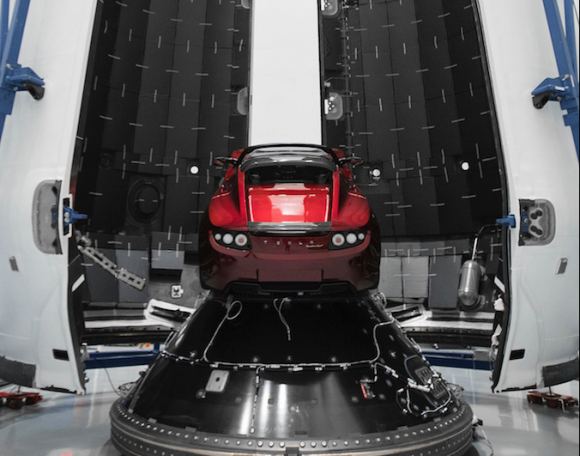After years of preparation, SpaceX is gearing up for the inaugural launch of its Falcon Heavy rocket. As the name would suggest, this rocket is the heaviest launch vehicle in the SpaceX arsenal. With a payload capacity of 54 metric tons (119,000 lbs), it can lift over twice as much weight of the next heaviest launch vehicle (the ULA’s Delta IV Heavy). And in time, SpaceX hopes to use this rocket to send astronauts into orbit, to the Moon, and on to Mars.
Basically, the Falcon Heavy is integral to SpaceX’s mission to usher in an age of affordable space travel and restoring domestic launch capability to the United States. With the inaugural launch scheduled to take place no earlier than January of 2018, the company is currently putting the final touches on the rocket. This includes releasing pictures of the payload which will be sent into space, which is none other than Elon Musk’s own cherry-red Tesla Roadster.
The inaugural launch will take place at SpaceX’s Launch Complex 39A, which is located at the Kennedy Space Center in Florida. This same launch pad was where the historic Apollo 11 mission launched from on July 16th, 1969, sending the first astronauts to the Moon. After it launches, the rocket will send send a payload into a heliocentric solar orbit, which will put it at a distance that is about the same as Mars’ distance from the Sun.
In addition, the company will use this inaugural launch to attempt a landing of all three of the Falcon 9 engine cores, which make up the first stage of the Falcon Heavy. In the past, the company has demonstrated its ability to successfully land the first stages of Falcon 9 rockets on land and at sea. However, this will be the first time that multiple cores are recovered from a single launch.
It will also demonstrate that SpaceX is capable of reusing all stages of a heavy launch, bringing it a step closer to fulfilling its promise to reduce costs by developing fully-reusable rockets. Two of the rocket cores will land at Cape Canaveral Air Force Station while the third will land on SpaceX’s drone ship (Of Course I Still Love You) out in the Atlantic Ocean.
NASA is also offering offering viewing opportunities of the launch to the public at the Kennedy Space Center Visitor Complex. In the past, Musk has proposed sending some truly odd things into space, including a wheel of cheese. On December 1st of this year, Musk tweeted that for this momentous occasion, the special cargo would be one of his very own electric cars. As he posted on Twitter:
Payload will be my midnight cherry Tesla Roadster playing Space Oddity. Destination is Mars orbit. Will be in deep space for a billion years or so if it doesn’t blow up on ascent.
— Elon Musk (@elonmusk) December 2, 2017

Last week, SpaceX released photos of the Tesla Roadster being loaded aboard the rocket’s payload fairing. Forthe purposes of launching it into space, the Roadster has been mounted on a special adapter structure, which are typically used when launching satellites into orbit. The photos also showed the Roadster being enclosed inside the rocket’s payload fairing, which will carry the car into space and place it at its heliocentric orbit.
Musk naturally avoided making any predictions about the launch, saying only that the launch was “Guaranteed to be exciting, one way or another.” However, when asked about his choice of cargo, Musk was both candid and cheeky in his response, tweeting:
“I love the thought of a car drifting apparently endlessly through space and perhaps being discovered by an alien race millions of years in the future.”
One can only imagine what they will conclude about humans. Perhaps that they were are both environmentally friendly and pretty flashy! While the exact date of the launch is still yet to be determined, Musk is certainly correct in predicting that it will be an exciting event. Given the sheer significance of this flight, the eyes of the world will be firmly fixed on Launch Complex 39A when it does take place.
Good luck SpaceX! And good luck to you too little Roadster!
Further Reading: Kennedy Space Center, Spaceflight Now, SpaceX


Odd choice for a music. Bowie’s Space Oddity is one of depressive songs I ever heard.
That seems to be a lesser-known fact about that song. Chris Hadfield made similar observations when his son suggested he do a cover of it aboard the ISS.
hello
In 2273 a mysterious and immensely powerful alien cloud known as T’sla approaches Earth, destroying everything in its path…
You’d think we learned our lesson from the V’ger incident 😉